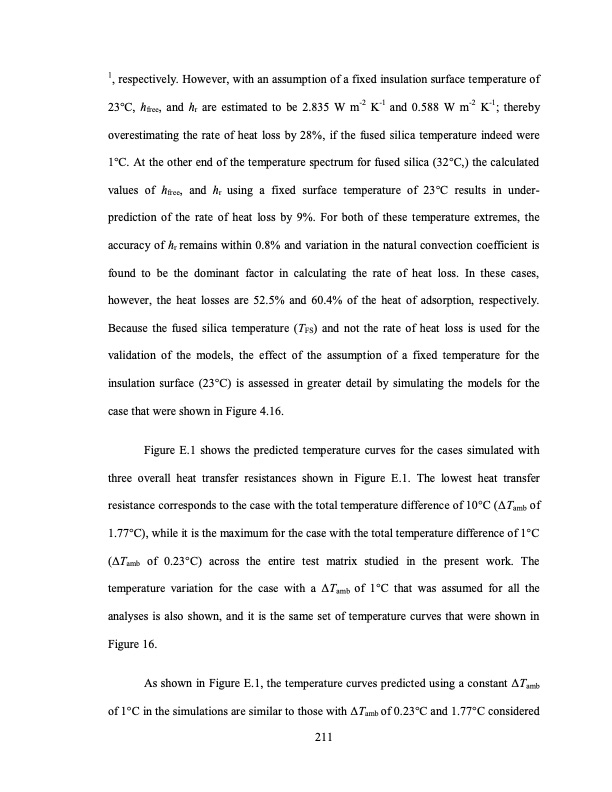
PDF Publication Title:
Text from PDF Page: 238
1, respectively. However, with an assumption of a fixed insulation surface temperature of 23°C, hfree, and hr are estimated to be 2.835 W m-2 K-1 and 0.588 W m-2 K-1; thereby overestimating the rate of heat loss by 28%, if the fused silica temperature indeed were 1°C. At the other end of the temperature spectrum for fused silica (32°C,) the calculated values of hfree, and hr using a fixed surface temperature of 23°C results in under- prediction of the rate of heat loss by 9%. For both of these temperature extremes, the accuracy of hr remains within 0.8% and variation in the natural convection coefficient is found to be the dominant factor in calculating the rate of heat loss. In these cases, however, the heat losses are 52.5% and 60.4% of the heat of adsorption, respectively. Because the fused silica temperature (TFS) and not the rate of heat loss is used for the validation of the models, the effect of the assumption of a fixed temperature for the insulation surface (23°C) is assessed in greater detail by simulating the models for the case that were shown in Figure 4.16. Figure E.1 shows the predicted temperature curves for the cases simulated with three overall heat transfer resistances shown in Figure E.1. The lowest heat transfer resistance corresponds to the case with the total temperature difference of 10°C (ΔTamb of 1.77°C), while it is the maximum for the case with the total temperature difference of 1°C (ΔTamb of 0.23°C) across the entire test matrix studied in the present work. The temperature variation for the case with a ΔTamb of 1°C that was assumed for all the analyses is also shown, and it is the same set of temperature curves that were shown in Figure 16. As shown in Figure E.1, the temperature curves predicted using a constant ΔTamb of 1°C in the simulations are similar to those with ΔTamb of 0.23°C and 1.77°C considered 211PDF Image | TEMPERATURE SWING ADSORPTION PROCESSES FOR GAS SEPARATION

PDF Search Title:
TEMPERATURE SWING ADSORPTION PROCESSES FOR GAS SEPARATIONOriginal File Name Searched:
PAHINKAR-DISSERTATION-2016.pdfDIY PDF Search: Google It | Yahoo | Bing
CO2 Organic Rankine Cycle Experimenter Platform The supercritical CO2 phase change system is both a heat pump and organic rankine cycle which can be used for those purposes and as a supercritical extractor for advanced subcritical and supercritical extraction technology. Uses include producing nanoparticles, precious metal CO2 extraction, lithium battery recycling, and other applications... More Info
Heat Pumps CO2 ORC Heat Pump System Platform More Info
| CONTACT TEL: 608-238-6001 Email: greg@infinityturbine.com | RSS | AMP |